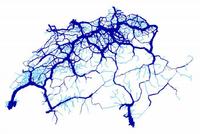|
|||||||||||
Alliance for Global Sustainability
Leitung
ETH Zürich
Prof. Dr. Kay W. Axhausen
Institut für Verkehrsplanung und Transportsysteme (IVT)
HIL F 31.3
Stefano-Franscini-Platz 5
8093 Zürich
Tel: +41 44 633 39 43
Fax: +41 44 633 10 57


Fundamental patterns of travel behaviour and their policy implications for land-use, congestion and air-quality
Partner des IVT
Massachusetts Institute of Technology (MIT), Center for Transportation Studies
University of Tokyo (UT), Graduate School of Engineering,Faculty of Engineering, Department of Urban Engineering, Urban Planning
Projektbearbeiter
Prof. Dr. Kay W. Axhausen
Anja Simma
Auftraggeber
Alliance for global sustainability: ETH Zürich, MIT, UT
Laufzeit
01.03.2001 - 28.02.2003
Kurzfassung
Reinforcing the separation of daily activities at ever-increasing distances, the growth in motorised travel has generated an increasing number of social problems at a growing scale. Today, transportation activities create externalities on virtually all aggregation levels, i.e. urban (land-use, congestion, urban air pollution), regional (acid rain, ozone), and (inter-) national (emissions of greenhouse gases). Policy makers worldwide, trying to cope with these problems need to base their decisions on sound analyses of travel behaviour; unfortunately, no such fundamental comparative large-scale studies exist to date.
Not surprisingly, in the absence of such systematic analysis confusion continues to exist in this area, since many policy measures are typically evaluated without fully understanding the dynamic linkages between our society and the transportation system. For example, many analysts have conducted comparisons between the European and U.S. transportation system, and explain differences in travel patterns by specific policy measures. They typically conclude that higher fuel prices, land-use and public transit oriented policies have lead to lower automobile usage (Pucher and Kurth, 1995; Newman and Kenworthy, 1999). Such studies, however, systematically overlook that European travel patterns result from similar forces as those in the U.S. and that the observed differences likely represent only a phase displacement in time (although the absolute levels of automobile usage may differ in the end) (see, e.g. Schafer, in press).
Thus, a profound understanding of mobility patterns and their underlying forces is crucial for formulating effective sustainable transportation policies. We plan to examine systematically a large number of urban and national travel surveys that (1) might reveal the existence of regularities in travel demand and supply over space and time, (2) indicate the extent to which travel patterns differ across different settings with respect to land-use (or population density), transport infrastructure and services, economic structure and culture; based on (1) and (2) allow the formulation of more appropriate policies to induce a shift toward more sustainable travel patterns.
Answering these questions is critical for a number of reasons. If travel behaviour is similar across all examined countries from the industrialised world and developing economies, the latter are likely to undergo a similar process of mobility increase as experienced in the industrialised world, which - in the absence of countermeasures - may thus lead to similar problems. Regularities in travel behaviour may also suggest that essentially the same basic transport policy packages may be applied everywhere, if trying to control for the transport-related problems indicated above. Examining the variability of travel patterns as a function of differences in land-use (or population density), culture, and the economic structures is an important second step as each specific setting may require additional policy measures. Based on such analyses, we evaluate a range of transport policies that aim at reducing the existing external effects. To ensure the broadest possible approach, our proposed analysis covers cities and countries from America, Asia, and Europe.
Wichtiger Hinweis:
Diese Website wird in älteren Versionen von Netscape ohne
graphische Elemente dargestellt. Die Funktionalität der
Website ist aber trotzdem gewährleistet. Wenn Sie diese
Website regelmässig benutzen, empfehlen wir Ihnen, auf
Ihrem Computer einen aktuellen Browser zu installieren. Weitere
Informationen finden Sie auf
folgender
Seite.
Important Note:
The content in this site is accessible to any browser or
Internet device, however, some graphics will display correctly
only in the newer versions of Netscape. To get the most out of
our site we suggest you upgrade to a newer browser.
More
information

